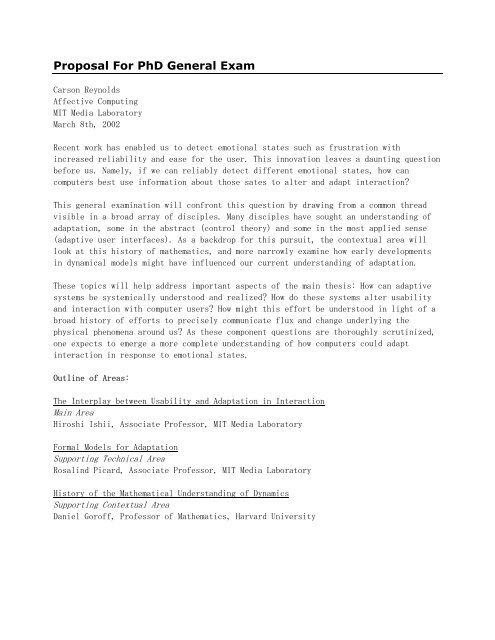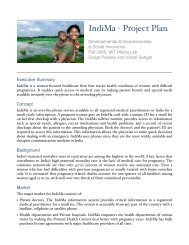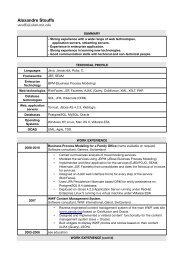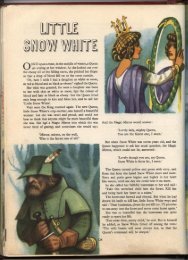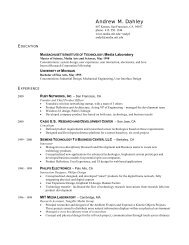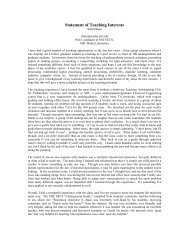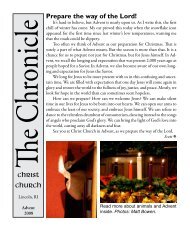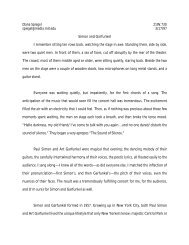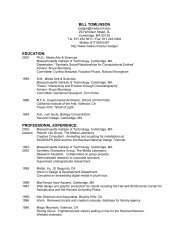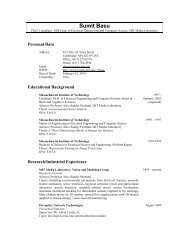Proposal For PhD General Exam - MIT Media Laboratory
Proposal For PhD General Exam - MIT Media Laboratory
Proposal For PhD General Exam - MIT Media Laboratory
You also want an ePaper? Increase the reach of your titles
YUMPU automatically turns print PDFs into web optimized ePapers that Google loves.
<strong>Proposal</strong> <strong>For</strong> <strong>PhD</strong> <strong>General</strong> <strong>Exam</strong><br />
Carson Reynolds<br />
Affective Computing<br />
<strong>MIT</strong> <strong>Media</strong> <strong>Laboratory</strong><br />
March 8th, 2002<br />
Recent work has enabled us to detect emotional states such as frustration with<br />
increased reliability and ease for the user. This innovation leaves a daunting question<br />
before us. Namely, if we can reliably detect different emotional states, how can<br />
computers best use information about those sates to alter and adapt interaction?<br />
This general examination will confront this question by drawing from a common thread<br />
visible in a broad array of disciples. Many disciples have sought an understanding of<br />
adaptation, some in the abstract (control theory) and some in the most applied sense<br />
(adaptive user interfaces). As a backdrop for this pursuit, the contextual area will<br />
look at this history of mathematics, and more narrowly examine how early developments<br />
in dynamical models might have influenced our current understanding of adaptation.<br />
These topics will help address important aspects of the main thesis: How can adaptive<br />
systems be systemically understood and realized? How do these systems alter usability<br />
and interaction with computer users? How might this effort be understood in light of a<br />
broad history of efforts to precisely communicate flux and change underlying the<br />
physical phenomena around us? As these component questions are thoroughly scrutinized,<br />
one expects to emerge a more complete understanding of how computers could adapt<br />
interaction in response to emotional states.<br />
Outline of Areas:<br />
The Interplay between Usability and Adaptation in Interaction<br />
Main Area<br />
Hiroshi Ishii, Associate Professor, <strong>MIT</strong> <strong>Media</strong> <strong>Laboratory</strong><br />
<strong>For</strong>mal Models for Adaptation<br />
Supporting Technical Area<br />
Rosalind Picard, Associate Professor, <strong>MIT</strong> <strong>Media</strong> <strong>Laboratory</strong><br />
History of the Mathematical Understanding of Dynamics<br />
Supporting Contextual Area<br />
Daniel Goroff, Professor of Mathematics, Harvard University
Main Area: The Interplay between Usability and Adaptation in Interaction<br />
<strong>Exam</strong>iner: Hiroshi Ishii<br />
Associate Professor of <strong>Media</strong> Arts and Sciences<br />
Tangible <strong>Media</strong> Group, <strong>MIT</strong> <strong>Media</strong> <strong>Laboratory</strong><br />
Description:<br />
This area seeks to cover literature on the topics of usability, its relationship to<br />
adaptation, and interface design. Readings are drawn primarily from usability, humancomputer<br />
interaction and design traditions with an emphasis on issues that directly<br />
address problems with adaptive techniques.<br />
Written Requirement:<br />
The goal of this topic will be, at minimum, to write a paper that surveys and discusses<br />
the conflicts between adaptive interfaces and usability. If that goal is accomplished,<br />
further work on prototypes for new types of interaction, in light of this inquiry, will<br />
be articulated and tested.<br />
Signature:___________________________________________ Date:_____________<br />
Reading List:<br />
<strong>General</strong> Usability:<br />
Adler, P.S. and Winograd, T.A. (Eds.) 1992. USABILITY: Turning<br />
Technologies into Tools. Oxford University Press: New York.<br />
Hayes, B. E. 1998. Measuring Customer Satisfaction: Survey Design, Use, and Statistical<br />
Analysis Methods. (Second Edition). American Society for Quality: Milwaukee, WI.<br />
Hix, D. and Hartson, H.R. 1993. Developing User Interfaces: ensuring<br />
usability through product and process. J. Wiley and sons.<br />
John, B. E., & Kieras, D. E. 1996. The GOMS family of user interface<br />
analysis techniques: Comparison and contrast. ACM Transactions on<br />
Computer-Human Interaction 3(4):320-351.<br />
Landauer, T. K. 1995. The Trouble with Computers: Usefulness, Usability,<br />
and Productivity, <strong>MIT</strong> Press: Cambridge, Mass.<br />
Nielsen, J. 1993. Usability Engineering, San Diego, Academic Press.<br />
Usability with Respect to Adaptive Interaction:<br />
Benyon, D. R. 1993. Adaptive Systems; a solution to usability problems.
User Modeling and User Adapted Interaction.<br />
Calvi, L. and de Bra, P. 1997. "Improving the Usability of Hypertext<br />
Courseware Through Adaptive Linking" in Proceedings of ACM Hypertext '97, Southampton,<br />
UK, 224-225.<br />
Caulton, D. and Dye, K. 1997. Do Users Always Benefit When User<br />
Interfaces Are Consistent? In Thimbleby, H., OConaill, B. and Thomas, P.<br />
(Eds) People and Computers XII - Proceedings of HCI '97, Springer, New<br />
York.<br />
Grudin, J. 1989. The case against user interface consistency. Communications of the ACM<br />
32, 10, 1164--1173.<br />
Greenberg, S. and Witten, I. H. 1985. "Adaptive personalized interfaces<br />
-- a question of viability." Behaviour and Information Technology, 4(1),<br />
pp. 31-45, January.<br />
Hook, K. 1997. Evaluating the Utility and Usability of an Adaptive<br />
Hypermedia System, Proc. of Intelligent User Interfaces, 179-186.<br />
Mitchel, J. and Schneiderman, B. 1989. Dynamic versus Static Menus: An<br />
Exploratory Comparison, ACM SIGCHI Bulletin 1989 v.20 n.4 p.33-37.<br />
Streeter, L., Nass, C., Keisler, S., and Shneiderman, B. 1995. Interface<br />
styles: Direct manipulation versus social interaction. In Proceedings of the CHI'95<br />
Conference on Human Factors and Computing. ACM Press, New York, N.Y. Denver, Colo.<br />
Totterdell, P. Rautenbach, P. 1990. Adaptation as a Design Problem.<br />
In: Adaptive User Interfaces, Dermot Browne, Peter Totterdell, Mike Norman (Eds), pp.<br />
59-84, Academic Press.<br />
Interface Architecture Approaches<br />
Langley, P. Machine learning for adaptive user interfaces. In Proceedings of the 21st<br />
German Annual Conference on Artificial Intelligence, pages 53--62, Freiburg, Germany,<br />
1997. Springer.<br />
Linton, M. A. Vlissides, J. M. and Calder, P. R. "Composing User Interfaces with<br />
InterViews," IEEE Computer, February 1989, pp. 8-24.<br />
Myers, B. et. al. "The Amulet Environment: New Models for Effective User Interface<br />
Software Development, " IEEE Transactions on Software Engineering. 1997b. 23(6). pp.<br />
347-365.
Myers, B. Giuse, D. Dannenberg, Zanden, R. B. Kosbie, D. Pervin, E. Mickish, A. and<br />
Marchal, P. "Garnet: Comprehensive Support for Graphical Highly Interactive User<br />
Interfaces," IEEE Computer, vol. 23, pp. 71-85, 1990.<br />
Scheifler, R.W. and Gettys, J. The X Window System. ACM Transactions on Graphics,<br />
5(2):79-109, 1986.<br />
Static and Dynamic Graphic Design<br />
Laurel, B., ed. 1990. The art of human-computer interface design. Reading, Mass.:<br />
Addison-Wesley.<br />
Meggs, P. 1992. A history of graphic design, 2nd ed. New York: Van Nostrand Reinhold.<br />
Mullet, K. and D. Sano. 1995. Designing visual interfaces: Communications oriented<br />
techniques. Englewood Cliffs, NJ: Sunsoft/Prentice Hall.<br />
Norman, D. A. 1988. The design of everyday things. New York: Basic Books.<br />
Shneiderman, B. 1992. Designing the user interface. 2nd Ed. Reading, Mass.: Addison—<br />
Wesley.<br />
Tufte, Edward, Visual explanations. Images and quantities, evidence and narrative,<br />
Cheshire (CT): Graphics Press, 1997, pp.156.<br />
Tufte, Edward, Envisioning information, Cheshire (CT): Graphics Press, 1990, pp.126.
Technical Area: <strong>For</strong>mal Models for Adaptation<br />
<strong>Exam</strong>iner: Rosalind Picard<br />
Associate Professor of <strong>Media</strong> Technology<br />
Affective Computing Group, <strong>MIT</strong> <strong>Media</strong> <strong>Laboratory</strong><br />
Description:<br />
This supporting area surveys different formal systemic models from adaptation. Drawing<br />
from a wide variety of different phenomena and algorithms that have been deemed<br />
adaptive, this area encompasses readings from a wide variety of disciplines. However<br />
each of these readings is of a primarily theoretical nature and relates directly to<br />
models for adaptation.<br />
Written Requirement:<br />
The goal of this area will be to produce a publication-quality survey/synthesis paper<br />
that provides a taxonomy and describes common mathematical models for adaptive<br />
behavior.<br />
Signature:___________________________________________ Date:_____________<br />
Reading List:<br />
Adaptive Control Systems<br />
Bellman, R. E. 1961. Adaptive Control Processes. New Jersey: Princeton University<br />
Press.<br />
Oppenheim, A. V. and Willsky, A. S. 1983. Signals and Systems. Englewood Cliffs, NJ:<br />
Prentice-Hall, 1983. [Chapters 9, 10, and 11]<br />
Stefani, R. T., Shahian, B., Savant, C. J., Hostetter, G. 2001. Design of Feedback<br />
Control Systems, Fourth Edition, Oxford: Oxford University Press.<br />
Sutton R.S., Barto A.G., Williams R.J. 1992. Reinforcement learning is direct adaptive<br />
optimal control.<br />
Optimization Methods for Adaptation<br />
Bishop, C. M. 1995. Neural networks for pattern recognition. Clarendon Press, Oxford.<br />
Goldberg, D. 1989. Genetic algorithms in search, optimization, and machine learning.<br />
Holland, J. 1975. Adaptation in Natural and Artificial Systems, The University of<br />
Michigan Press.
Jacobs, R. A., Jordan, M. I., Nowlan, S. J., & Hinton, G. E. 1991. Adaptive mixtures of<br />
local experts. In Neural Computation 3, pp. 79-87, <strong>MIT</strong> press.<br />
Kirpatrick S., Gelatt, C.D. Vecchi, M.P. 1983. Optimization by simulated annealing.<br />
Science 220, 671-680.<br />
Rumelhart, D. E., Hinton, G. E., & Williams, R. J. 1986. Learning internal<br />
representations by error propagation. In Rumelhart, D. E., & McClelland, J. L. (Eds.),<br />
Parallel Distributed Processing: Explorations in the Microstructure of Cognition,<br />
Volume 1: Foundations<br />
Shewchuk, J.R., 1994. An Introduction to the Conjugate Gradient Method Without the<br />
Agonising Pain, Internal Report, School of Computer Science, Carnegie Mellon<br />
University, Pittsburgh, PA, USA, Aug. 1994 (available at<br />
http://www.cs.cmu.edu/~jrs/jrspapers.html).<br />
Equilibria in Biological Systems<br />
Ashby, W.R. 1952. Design for a Brain. London: Chapman and Hall.<br />
Bernard, C. 1957. An Introduction to the Study of Experimental Medicine. Dover.<br />
Thompson. D. W. 1961. On Growth and <strong>For</strong>m, Abridged Edition. University Press,<br />
Cambridge.
Contextual Area: History of the Mathematical Understanding of Dynamics<br />
<strong>Exam</strong>iner: Daniel Goroff<br />
Professor of the Practice of Mathematics<br />
Department of Mathematics, Harvard University<br />
Description:<br />
Using historical evidence, this supporting area will provide an understanding of how<br />
models for dynamical systems developed. The area will consist of a brief review of the<br />
complete history of mathematics and a more in depth look at how Dynamics evolved and<br />
influenced later developments such as models for chaotic phenomena.<br />
Written Requirement:<br />
The goal of this area will be to produce a paper that seeks to connect up the<br />
postulations made in the development of models for dynamics to those that underpin<br />
models for adaptive behavior.<br />
Signature:___________________________________________ Date:_____________<br />
Reading List:<br />
Abraham, R. and Marsden, J. 1978. The Foundations of Mechanics. Second Edition:<br />
Addison-Wesley.<br />
Abraham, R. and Shaw, C. 1992. Dynamics, the Geometry of Behavior. Third Edition:<br />
Dakota Books.<br />
Alexander, D. S. 1994. History of complex dynamics : from Schroder to Fatou and Julia<br />
Braunschweig,<br />
Ball, W. W. Rouse. 1960. A short account of the history of mathematics. Macmillan,<br />
London, 1888. Reprint: Dover, New York.<br />
Bourbaki, Nicolas. 1994. Elements of the history of mathematics. Springer-Verlag, New<br />
York. Translated from the French edition: Eléments d'histoire des mathématiques.<br />
[excerpts]<br />
Birkhoff, G. (ed.) 1959. Orbit Theory. Proceedings of Symposia in Applied Mathematics<br />
Volume IX.. American Mathematical Society, 1st. Edition.<br />
Birkoff, G. 1978. Ordinary Differential Equations. New York: John Wiley, 3rd edition.<br />
Cajori, Florian. 1894. A history of mathematical notations. Macmillan, New York,<br />
Second edition: Macmillan, New York, 1919.
Cannon, J. T. and Dostrovsky, S. 1981. The evolution of dynamics : vibration theory<br />
from 1687 to 1742 New York.<br />
Ekeland, Ivar. 1988. Mathematics and the Unexpected. xiii, 146 p., 2 halftones.<br />
University of Chicago Press.<br />
Goroff, Daniel. 1993. “Henry Poincaré and the Birth of Chaos Theory: An Introduction<br />
to the English Translation of Les Méthodes Nouvelles de la Mécanique Céleste, New<br />
Methods of Celestial Mechanics.” in: Méthodes nouvelles de la mécanique céleste. Ed.<br />
and Trans. By Goroff, Daniel (American Institute of Physics, Woodbury, NY, 1993), Vol<br />
1.<br />
Klein, Morris. 1972. Mathematical Thought From Ancient to Modern Times (Vols 1-3).<br />
Wiles, New York, Oxford University Press. [excerpts]<br />
Moser, J. 2001. Stable and Random Motions in Dynamical Systems: With Special Emphasis<br />
on Celestial Mechanics. Princeton University Press.<br />
Ruelle, D. 1991. Chance and Chaos. Princeton University Press.<br />
Sarton, George. 1927. Introduction to the history of science, volume I. Williams &<br />
Wilkins, Baltimore.<br />
Smith, David Eugene. 1958. History of Mathematics. Two volumes. Boston, 1923-1925.<br />
Reviewed: Isis 6, 440-444. Reprints: Ginn, Boston, 1951-1953 Dover, New York.<br />
Smale, Stephen. 1986. The Mathematics of Time : Essays on Dynamical Systems, Economic<br />
Processes, and Related Topics. Springer Verlag.<br />
Struik, Dirk J. 1967. A concise history of mathematics. Revised edition: Dover, New<br />
York,<br />
Truesdell, C. 1921. Essays in the history of mechanics, Berlin.
Biography:<br />
Daniel L. Goroff<br />
Daniel Goroff is Professor of the Practice of Mathematics at Harvard University, where he also<br />
serves as Associate Director of the Derek Bok Center for Teaching and Learning, and as a<br />
Resident Tutor at Leverett House. He earned his B.A.-M.A. degree in mathematics summa cum laude<br />
at Harvard as a Borden Scholar, an M.Phil. in economics at Cambridge University as a Churchill<br />
Scholar, and a Ph.D. in mathematics at Princeton University as a Danforth Fellow.<br />
A 1988 Phi Beta Kappa Teaching Prize winner, Goroff has taught courses for the mathematics,<br />
economics, physics, and history of science departments at Harvard since joining the faculty in<br />
1983. In pursuing his work on nonlinear systems, chaos, and decision theory, he has held<br />
visiting positions at the Institut des Hautes Etudes Scientifiques in Paris, the Mathematical<br />
Sciences Research Institute in Berkeley, Bell Laboratories in New Jersey, and the Dibner<br />
Institute at <strong>MIT</strong>.<br />
In 1994, Goroff was elected to a three year term on the Board of Directors of the American<br />
Association for Higher Education (AAHE). During 1996-97, Goroff was a Division Director at the<br />
National Research Council (NRC) in Washington, and during 1997-98, he worked for the President's<br />
Science Advisor at the White House Office of Science and Technology Policy (OSTP). That year he<br />
was named a “Young Leader of the Decade in Academia” by Change: The Magazine of Higher<br />
Education.<br />
As Director of the Joint Policy Board for Mathematics (JPBM) beginning in 1998, Daniel Goroff<br />
was called to testify about scientific education and research priorities both by the House and<br />
again by the Senate during the 106th Congress. He currently serves as Chair of the U.S.<br />
National Commission on Mathematics Instruction at the National Research Council and co-directs<br />
the Scientific Workforce Project of the National Bureau of Economic Research.<br />
Home Telephone: 617-493-2777 Fax Line: 617-495-3739<br />
Office Telephone: 617-495-2168 E-mail: goroff@math.harvard.edu


